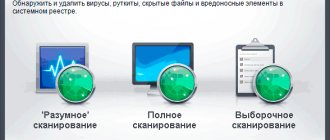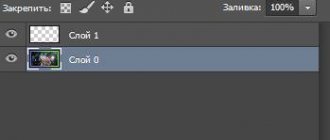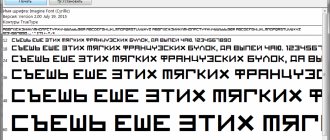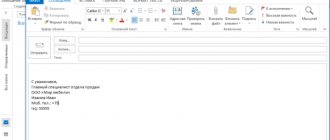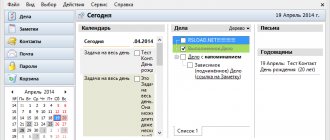Dictionary of computer terms and Internet slang
An image map (English image map, sometimes a touch map or graphic map ) is a graphic object of the HTML markup language associated with an image and containing special areas (active zones), when clicked on, a transition to a specific URL occurs (using javascript you can set other actions). Using image maps allows you to store multiple links in a single image.
A sitemap is a list of site pages for search engines or users and is similar to the Contents section of a regular book. Used as a navigation element, showing the relationship between the pages of the site. This is a complete list of sections and/or all pages in hierarchical order. In XML format it is used for search engines, and in HTML format it is used for users to help find the necessary information that is on the site. Read more about sitemaps. Order the creation of site map(s).
Cascading style sheets ( CSS /siːɛsɛs/) are a formal language for describing the appearance of a document written using a markup language. Primarily used as a means of describing the appearance of web pages written using HTML and XHTML markup languages, but can also be applied to any XML documents, such as SVG or XUL. CSS is used by web page creators to specify colors, fonts, block placement, and other aspects of the appearance of those web pages. The main purpose of developing CSS was to separate the description of the logical structure of a web page (which is done using HTML or other markup languages) from the description of the appearance of that web page (which is now done using the formal language of CSS). This separation can increase document accessibility, provide greater flexibility and control over its presentation, and reduce complexity and repetition in structural content. In addition, CSS allows the same document to be presented in different styles or output methods, such as screen presentation, printed presentation, voice reading (by a special voice browser or screen reader), or output by devices that use Braille. Order work with styles (CSS) of the site(s).
Quoting (English quoting) - quoting an interlocutor’s comment during discussions on forums ↓ in blogs ↑ and other forms of Internet communication.
A cyber attack (hacker attack) is an attempt on the information security of a computer system with the aim of disabling it, seizing control over it (increasing access rights) or obtaining some confidential data without the knowledge of the owners. One of the ways to carry out a cyber attack is to introduce so-called viruses ↑
Cybernetics (ancient Greek κυβερνητική “the art of control”) is the science of the general laws of receiving, storing, transforming and transmitting information in complex control systems, be they machines, living organisms or society.
Cybercrime - crimes committed in the field of information technology ↑
Cyberspace , a metaphorical abstraction used in philosophy and computer technology, is a (virtual) reality that represents the Noosphere. The second world is both “inside” computers and “inside” computer networks.
Cyber espionage or computer espionage (possibly “cyber intelligence”) is a term that usually refers to the unauthorized acquisition of information for the purpose of obtaining personal, economic, political or military superiority, carried out by bypassing (hacking) computer security systems, using malicious software, including Trojan horses and spyware. Cyber espionage can be carried out both remotely, using the Internet, and by penetrating into computers and computer networks of enterprises by ordinary spies (“moles”), as well as hackers ↓ More recently, cyber espionage also includes analysis by intelligence services of the behavior of users of social networks such as Facebook and Twitter in order to identify extremist, terrorist or anti-government activities.
Kilobyte (KB, KB) - a unit of measurement of the amount of information, equal to 1024 bytes ↑
Cyrillic is the ninth block of the Unicode standard ↓ Contains all the letters of the main Cyrillic alphabet, as well as additional letters for Slavic and non-Slavic alphabets.
Keyboard is a set of keys arranged in a certain order for controlling a device or for entering data. As a rule, buttons are pressed with your fingers. Slang abbreviation - clave .
A class is a software element ↓ describing an abstract data type and its partial or complete implementation. Other abstract data types - metaclasses, interfaces, structures, enumerations - are characterized by some of their own, other features. Along with the concept of “object,” class is a key concept in OOP ↓ (although there are also classless object-oriented languages, for example, Self, Lua; see Prototype Programming for more details). The essence of the difference between classes and other abstract data types is that when specifying a data type, a class simultaneously defines both an interface ↑ and an implementation for all its instances, and calling the constructor method is required. In practice, object-oriented programming ↓ comes down to creating a number of classes, including an interface and implementation, and then using them. A graphical representation of a number of classes and the relationships between them is called a class diagram. During its development, the object-oriented approach has accumulated many recommendations (patterns) for creating classes and class hierarchies. The idea of classes came from work on knowledge bases related to artificial intelligence research. The classifications used by humans in zoology, botany, chemistry, and machine parts carry the basic idea that any thing can always be represented as a special case of some more general concept. A specific apple is an apple in general, an apple in general, and any apple in general is a fruit. This is why class examples in object-oriented programming tutorials so often refer to apples and pears.
The storage class of a variable is a concept in some programming languages. It determines the scope of the variable, as well as how long the variable ↓ resides in memory.
A client is a hardware or software component of a computer system that sends requests to the server ↓ A client program interacts with the server using a specific protocol. It can request any data from the server, manipulate data directly on the server, launch new processes on the server, etc. The client program can provide the data received from the server to the user or use it in some other way, depending on the purpose of the program. The client program and the server program can run on the same computer or on different ones. In the second case, a network connection is used to exchange information between them.
A keyword or keyword is a word in a text that, together with other keywords, can provide a high-level description of the content of a text document, allowing one to identify its subject matter. Keywords in text analysis (including when building an index in search engines ↓) are particularly important, generally understandable, capacious and indicative words in a text for a particular culture, a set of which can provide a high-level description of its content for the reader, providing a compact presentation and storing its meaning in memory. Keywords are actively used when promoting a website in search engines, the so-called SEO ↓ as well as when setting up campaigns in contextual advertising ↓ Read more about the types of keyword matches in Yandex.Direct and Google Advertising.
Codec (English codec (coder/decoder – encoder/decoder) is a computer program for compressing and decompressing a digital media file, such as an audio or video file.
Coder is a programmer ↓ specializing in coding - writing source code ↑ according to given specifications.
Compiler - a program or technical tool that performs compilation ↓
Compilation is the translation of a program ↓ compiled in a high-level source language into an equivalent program in a low-level language close to machine code (absolute code, object module, sometimes into assembly language ↓). The input information to the compiler ↑ (source code ↑ ) is a description of the algorithm or program in a domain-specific language, and the output of the compiler is an equivalent description of the algorithm in a machine-oriented language (object code).
Compile - translate a machine program from a domain-specific language into a machine-oriented language.
A computer (English computer, /kəmˈpjuː.tə(ɹ)/ - calculator) is a device or system capable of performing a given, clearly defined, changeable sequence of operations. These are most often operations of numerical calculations and data manipulation, but they also include input-output operations. A description of a sequence of operations is called a program. Slang abbreviation - comp .
Computer system is any device or group of interconnected or adjacent devices, one or more of which, acting in accordance with a program, performs automated data processing.
Computer scientist - computer specialist, programmer ↓
Conversion in Internet marketing ↑ is the ratio of the number of site visitors who performed any targeted actions on it (hidden or direct instructions from advertisers, sellers, content creators - purchase, registration, subscription, visiting a specific page of the site, clicking on an advertising link), to the total number of site visitors, expressed as a percentage. For example: you have an online store selling some products. If 100 people visited it per day and 9 of them made purchases, then the percentage of conversion of visitors and buyers is equal to (9 purchases/100 visitors) * 100% = 9%. Successful conversion is interpreted differently by sellers, advertisers, or content providers. For example, for a seller, a successful conversion would mean a purchase transaction by a consumer who became interested in the product by clicking on the corresponding advertising banner. For a content provider, a successful conversion could be visitors registering on the site, subscribing to an email newsletter, downloading software, or some other action expected from visitors.
Connect - connect, establish a connection, call your provider (usually a modem connection). Connect - connection.
Contextual advertising is a type of Internet advertising in which an advertisement is displayed in accordance with the content and context of the Internet page (Latin contextus - connection, connection). In the headlines, such ads usually contain words or groups of words (keywords), which are a hyperlink leading to the advertiser's page. Contextual advertising is generated and sold by search engines, such as Google, Yandex, Begun at Rambler, etc. It is placed directly in the search engine results or on partner sites.
Content (English: content) is any information content of something. For example, website content - texts, images, videos, etc., which are posted on this site.
Copy paste (eng. copy paste - copy-paste) - creating a document by arranging it from several ready-made blocks of text copied somewhere.
Copyright (eng. copyright - copy, reproduce and right) - rights to use and distribute products that can be copied (texts, photographs, music, videos, computer programs, etc.) and replicated. Not identical in meaning to the expression “copyright”, which often means only the rights of authors, but not related rights.
Copywriting (English copywriting (copy - manuscript, text material + write - write)) is a professional activity in writing advertising and presentation texts. These can be considered all texts that directly or indirectly advertise or popularize a product, company, service, person, or idea. Copywriter is a specialist involved in copywriting, i.e. writing texts.
A corporate website is the official website of a company, its full-fledged virtual representation on the Internet. In addition to detailed information about the company, its products and/or services, a corporate website may contain news (or a corporate blog), a product catalog (with the possibility of online purchase (with payment through payment systems on the site or only upon receipt) or without it), forms feedback (ordering through the website, subscribing to the newsletter), forum, online chat and some other elements related to the specifics of the activities of a particular company. The design of a corporate website is usually carried out taking into account the corporate style of the company. Order the creation of a corporate website.
Crawler - see search robot ↓
Crawl (English crawling - crawling) - the process of detection by a search robot (crawler) of new pages on the Internet and updates (changes) in those pages that are already present in the search engine index ↓ Crawl begins with scanning and collecting data about the pages of sites on the network for subsequent processing on the search engine servers. The crawled page will not necessarily be indexed. The construction of an index for search results is carried out on the basis of complex algorithms that differ among different search engines.
Cryptocurrency is a type of digital currency, the creation and control of which is based on cryptographic methods. As a rule, cryptocurrency accounting is decentralized. The operation of these systems is based on technologies such as blockchain, directed acyclic graph, consensus registry (ledger), etc. Information about transactions is usually not encrypted and is available in clear text. To ensure the immutability of the base of the transaction block chain, cryptographic elements are used (digital signature based on a public key system, sequential hashing). The term was established after the publication of an article about the Bitcoin system ↑ “Crypto currency”, published in 2011 in Forbes magazine. The author of Bitcoin himself, like many others, used the term “electronic cash”. A cryptocurrency can be developed from scratch or use the publicly available source code of another cryptocurrency. If, in addition to the code, the new cryptocurrency also uses the existing block chain of the original cryptocurrency, such cryptocurrency is called a fork of the original cryptocurrency. For their emission, different cryptocurrencies use mining, forging or ICO. There are ongoing discussions about the economic essence and legal status of cryptocurrencies. Depending on the country, cryptocurrencies are considered a means of payment, a specific product, and may have restrictions on circulation (for example, a ban on transactions with them for banking institutions).
Cron ( cron ) is a classic daemon ↑ (computer program in UNIX-class systems) used to periodically execute tasks at a certain time. Regular actions are described by instructions placed in crontab files and in special directories. The name cron is derived from the Greek word χρόνος (hrόnos) - time (in English - cronos).
Cooler (eng. cooler - cooler) or cooler is the name of an air cooling system - a set of fans and radiators installed on electronic components of a computer with increased heat generation (usually more than 5 W): central processor ↓ graphics processor ↑ chipset chips ↓
Cookie (English cookie - “cookie” (literal translation)) is a slang word that later became an official term and denotes a small piece of data about the user, programmatically created by a web server and stored as a separate file on the user’s computer for identification by the website , as well as for storing user settings and preferences somewhere on the network, for example on a social networking site or online store.
Cache (English cache - hiding place, reserve) is an array of computer's super-RAM, which is a buffer between the rather slow system memory and the processor. This array stores the data that the processor is currently working with. This data is not saved when the power is turned off. Caching is the accumulation of data in RAM for quick retrieval as needed. Caching speeds up the information processing process.
Folksonomy
Type of object classification. This is something like manual sorting of information, which is carried out jointly by a group of people. As a rule, we are talking about classifying something on the Internet - it is more convenient there. For example: lovers of children's literature create, say, a collection of children's e-books on the Internet. Then they mark the books they know with some marks (tags). Each to their own.
More often, the set of tags is discussed in advance, and you cannot go beyond it. For example, in our case, these could be tags: “for children”, “classics”, “no pictures”, “boring”, “bad translation”, “Agniya Barto”, “poems”, “unreadable”, “adventures” " etc.
A popular site that uses folksonomy is the photo hosting site Flickr. Here users upload their photos by tagging them. Each photo can be tagged by anyone who has registered on the site.
Sooner or later, if the community is active, almost every book will receive several of the same tags, set by different people. This means: several people find this book to satisfy these particular tags. All members of the community can rely on them when choosing something for their offspring.
Artificial neural network (ANN)
This is an artificial analogue of a biological neural network, which allows you to automate the solution of many problems. Most of the achievements of artificial intelligence today are associated with artificial neural networks.
The first simple artificial neural network appeared in 1960. A century later, will the progress of such networks lead to the emergence of merciless terminators? Only John Connor knows this.
In essence, an artificial neural network is a special type of computer program, and such a program runs on one or more computers, respectively.
The most interesting property of an artificial neural network is its learning ability . If the task of the program is to distinguish women from men in photographs, then through an artificial neural network you need to “pass” as many different images as possible, suggesting the correct answer.
In the process of such “training”, increasingly accurate algorithms for determining a person’s gender from his image are formed within the neural network - this happens in a semi-automatic mode, the network learns from its mistakes.
Autoencoder (AE)
It is a special type of unsupervised artificial neural network that provides compression and other machine learning features.
The simplest architecture of an autoencoder is a feed-forward network, without feedback, containing an input layer, an intermediate layer, and an output layer. The main principle of operation and training of the autoencoder network is to obtain a response at the output layer that is closest to the input.
